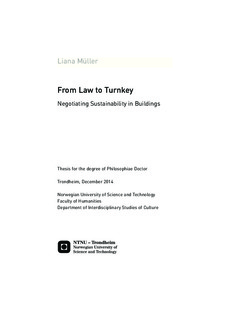| dc.contributor.author | Müller, Liana | |
| dc.date.accessioned | 2015-03-20T09:35:27Z | |
| dc.date.available | 2015-03-20T09:35:27Z | |
| dc.date.issued | 2014 | |
| dc.identifier.isbn | 978-82-326-0654-2 (printed ver.) | |
| dc.identifier.isbn | 978-82-326-0655-9 (electronic ver.) | |
| dc.identifier.issn | 1503-8181 | |
| dc.identifier.uri | http://hdl.handle.net/11250/279938 | |
| dc.description.abstract | This PhD thesis provides an analysis of central processes related to the creation, negotiation and communication of the future sustainable building in Norway.
Both researchers and practitioners have pointed at the Planning and Building Act as a central means to speed up the process and to set the frames for a sustainable development. Based on interviews with experts, I conclude that the building laws are never a direct translation of research results, EU directives and international agreements. These have to be translated, adapted and mediated, i.e. domesticated, to the Norwegian climate and cultural conditions.
Particularly in Norway, building researchers consider the Passive Houses (PH), extra-low energy buildings with a focus on energy efficiency, as a necessary step in a sustainable development of buildings. A closer scrutiny of the PH development in Germany and Austria helps us to understand and describe the factors that have made the voluntary PH standard a success in these two countries.
However, the initial political support for the Norwegian PH standard as technical requirement ignited a controversy among engineers, architects, physicians, physicists, policy-makers and practitioners. In the analysis of this path-dependency controversy I conclude that the disagreements address the technological concept but also its implications in society, health, culture, research and education.
The knowledge produced in the research environment and the political decisions are brought to a broader public by the media. The analysis of newspaper articles on low energy concepts reveals that the media in Norway has relied heavily on experts’ knowledge to mediate the news: also the mediation of the sustainable building has become an expert task, with little public scrutiny. | nb_NO |
| dc.language.iso | eng | nb_NO |
| dc.publisher | NTNU | nb_NO |
| dc.relation.ispartofseries | Doctoral thesis at NTNU;2014:370 | |
| dc.relation.haspart | Paper 1: Müller, Liana. The legal dwelling: how Norwegian research engineers domesticate construction law. This is an Accepted Manuscript of an article published by Taylor & Francis in "Engineering Studies" Accepted: 30 Oct 2014, available online March 2015 <a href="http://dx.doi.org/10.1080</a> /19378629.2014.1001396 " target="_blank"> http://dx.doi.org/10.1080/19378629.2014.1001396</a> | nb_NO |
| dc.relation.haspart | Paper 2: Muller, Liana; Berker, Thomas. Passive House at the Crossroads: The Past and the Present of a Voluntary Standard That Managed to Bridge the Energy Efficiency Gap. NOTICE: this is the author’s version of a work that was accepted for publication in <Journal title>. Changes resulting from the publishing process, such as peer review, editing, corrections, structural formatting, and other quality control mechanisms may not be reflected in this document. Changes may have been made to this work since it was submitted for publication. A definitive version was subsequently published in "Energy Policy" Vol.60, Pages 586–593, 2013 <a href="http://dx.doi.org/10.1016/j.enpol.2013.05.057 " target="_blank"> http://dx.doi.org/10.1016/j.enpol.2013.05.057</a> | nb_NO |
| dc.relation.haspart | Paper 3: Muller, Liana; The way towards zero-emission buildings: The Passive House controversy in Norway | nb_NO |
| dc.relation.haspart | Paper 4: Muller, Liana; Berker, Thomas.
Conspicuous Domestication:
Expert-Based Media Coverage of
Low-Energy Buildings in Norway
(2005-12) | nb_NO |
| dc.title | From Law to Turnkey: Negotiating Sustainability in Buildings | nb_NO |
| dc.type | Doctoral thesis | nb_NO |
| dc.subject.nsi | VDP::Humanities: 000::Cultural science: 060 | nb_NO |
